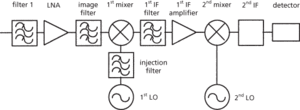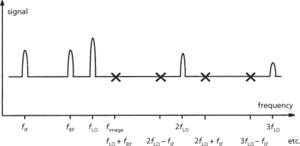A process whereby a receiver‐a heterodyne receiver‐employs the mixing of the incoming signal with a signal of a different frequency, produced by a local oscillator (LO), to create a signal at a frequency that is the difference between the two; this is the intermediate frequency (IF). The signal at the IF retains all the modulation of the original signal frequency, and hence this technique can be used in a radio receiver, for example. The heterodyne technique offers advantages over direct detection of the incoming signal including improved selectivity and sensitivity.
A typical heterodyne receiver using two mixing stages is shown in Fig. a. The first stage is a filter, called the preselector. This is usually a low-pass or band-pass filter to restrict the range of input signal frequencies to the desired range; it also limits the amount of noise received. The next stage is a low-noise amplifier (LNA), used to boost the level of the incoming signal; this improves the sensitivity of the receiver. The (optional) image filter is used to remove signals at the image frequency, which is the other frequency that when mixed with the local oscillator will produce a signal at IF. The frequency relationships are illustrated in Fig. b, including mixer harmonics and higher-order mixing terms.

(a) Typical two-stage heterodyne receiver

(b) Frequency relationships in a heterodyne mixing stage
The mixer is a nonlinear stage in which the input signal and local oscillator signal are combined to produce the IF. The signal at IF can then be filtered, to define the selected channel bandwidth, and amplified, to improve the sensitivity of the receiver. The combination of IF filtering and IF amplifier is often called the IF strip. The overall receiver selectivity is determined by the final-stage IF in a multistage receiver. A receiver may use several stages of intermediate frequencies to improve the performance; different filter types with various characteristics are available in different frequency ranges, and the IFs can be chosen to optimize the filter choice.
Compare direct conversion receiver.
- vitroclastic
- monadic
- monadic operation
- monadnock
- Monadology
- monalphabetic
- monarchy
- Monasteries, Dissolution of the (1536–40)
- monastery
- monatomic molecule
- monazite
- monchiquite
- Monck, George, 1st Duke of Albemarle (1608–70)
- MOND
- Mondex
- Mond, Ludwig (1838–1909)
- Mond nickel process
- Mond process
- Monel
- Monel metal
- Monera
- MONET
- monetarism
- monetary base
- monetary control